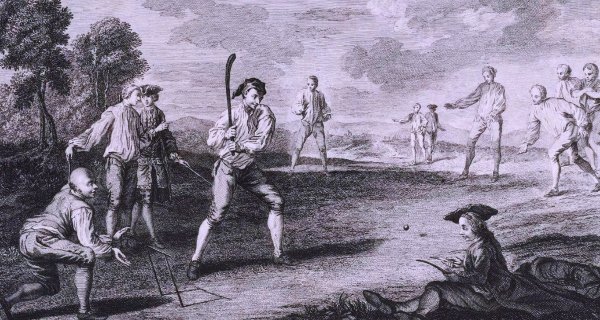Cricket in England is no less strange than true—young men have played cricket matches against maidens who have husbands, brothers, and sweethearts for their spectators. Cricket is the universal pastime of the people. The men of Devon, who formerly deemed all sports inferior to wrestling,. and the Somerset boys, who do upon the manly game of single stick, have lately given some attention to cricket, which is every-where growing into favor with the people, especially in the northern and southern counties.
Origin:
The exact period when the stimulating game of cricket originated, is unknown. The name is supposed to be derived from the Saxon cycle, or circle, a stick or staff with which the ball was struck. In Stowe’s Survey of London, published in 1599, it is enumerated among the games practiced by the citizens, but nothing is stated relative to how it was played, or the laws by which it was regulated.
The celebrated humorist, Tom D’Urfey, who acquired the favor of Charles II through the composition of ballads in which mirth and party spirit were combined, has mentioned cricket in his Pills to Purge Melancholy—the song “of a noble race was Shenkin,” commencing thus, “She was the prettiest fellow At football or cricket, At hunting chance, or nimble race, How featly her could prick it.”
The appellation has not been traced earlier than these authorities, though Strutt asserts that cricket originated from the game of club-ball, two engravings of which are given by him in his Sports and Pastimes. The first is copied from a Ms. in the Bodleian Library, dated 1334. It exhibits a female figure in the action of throwing the ball to a man whose bat is elevated to strike it. “Behind the women,” he says, “appear, in the original delineation, several other figures of both sexes waiting attentively to catch or stop the ball when returned by the batsman.”
The second, which also presents two players, is more ancient than the first and is taken from a genealogical roll of the Kings of England to the time of Henry III, in the Royal Library. This differs from the former, with the batsman having possession of the ball as well. which, Strutt adds, “he either threw into the air and struck with his bat as it descended, or cast forcibly on the ground and beat it away when it rebounded: the attention of his antagonist to catch the ball need not be remarked. It does not appear in either of these instances how the game was decided.”
Stool-Ball:
The worthy chronicler’s description of this game is an invention founded upon his interpretation of these figures, which in the original MSS are merely subordinate, without the least reference explanatory of the detail Strutt has added to them, and which appears to be the basis of his opinion that cricket originated from club-ball.
It may be remarked that the game of stoolball seems to bear a great resemblance to cricket. It differed chiefly in the hand being used instead of a bat and a stool substituted for the wicket, before which one of the players took his station while another, from a proper distance, delivered the ball to hit the stool. If he succeeded, his adversary was out, but if, on the contrary, the ball was struck back, the striker counted one towards his game, provided the bowler did not catch the ball before it had grounded; in this case, the striker was likewise out. The game was won by the party that scored the greatest number of points before the stool was struck by the ball.
If this elegant and healthful re-creation did not spring from either of the sources we have described, it may reasonably be inferred that we are indebted to a less ancient and more refined period for its scientific and complicated construction.
According to the earliest description of the game, under its modern appellation, the distance between the wickets was twenty-two yards, the same as at present. Each wicket was composed of two stumps and one bail; between the former, a hole was made in which the batsman, to obtain a run, was obliged to ground his bat before the wicketkeeper could place the ball therein.
This rule subjected the wicketkeeper’s hands to great injury, as it frequently happened that they were in the hole at the same instant as the striker’s bat. The unpleasant collision led to the introduction of the popping crease and to the stumps, which were previously only one foot in height, being increased by ten inches. The hole was abolished, and the wicketkeeper must stump out the batsman with the ball in hand.
Safe Style
In the middle of the last century, no particular weight was prescribed for the ball; and the perfection of bowling consisted of varying the delivery as much as possible: “long hops and half volleys,’ “grounders and home tosses” succeeded each other, either faster or slower, as the bowler considered it most likely to perplex his antagonist. Bats were made very differently from “Duke’s, Budd’s, Page’s, Dark’s, or Clapshaw’s best” of the present day: *the handle was considerably shorter, and the blade long and narrow, bowed out in front and curved at the back.
Such implements as these were ill-adapted even for what is termed “slashing hitting,” and upon the introduction of the system of bowling length bails, this style of bat was found to be an insufficient defense to the wicket. It was accordingly altered to the straight form, which presented greater advantages to the striker in blocking and, placing him on a more equal footing with the bowler, was the foundation of that safe style of play that this scientific game has gradually attained. — (through An Old Writer’s Estes).
Read More: Fred Trueman is a great entertaining fast bowler
